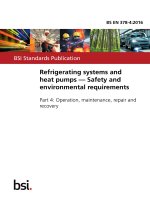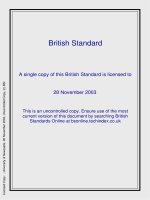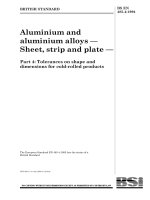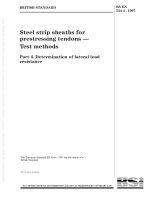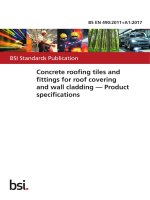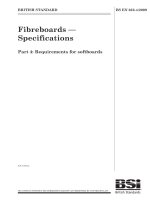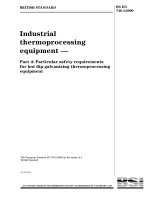Bsi bs en 61000 4 10 2017
Bạn đang xem bản rút gọn của tài liệu. Xem và tải ngay bản đầy đủ của tài liệu tại đây (4.39 MB, 48 trang )
BS EN 61000-4-10:2017
BSI Standards Publication
Electromagnetic
compatibility (EMC)
Part 4-10: Testing and measurement
techniques — Damped oscillatory magnetic
field immunity test
BRITISH STANDARD
BS EN 61000-4-10:2017
National foreword
This British Standard is the UK implementation of EN 61000-4-10:2017. It is
identical to IEC 61000-4-10:2016. It supersedes BS EN 61000-4-10:1994
which is withdrawn.
The UK participation in its preparation was entrusted by Technical Committee GEL/210, EMC - Policy committee, to Subcommittee GEL/210/11,
EMC - Standards Committee.
A list of organizations represented on this committee can be obtained on
request to its secretary.
This publication does not purport to include all the necessary provisions of
a contract. Users are responsible for its correct application.
© The British Standards Institution 2017.
Published by BSI Standards Limited 2017
ISBN 978 0 580 88430 6
ICS 33.100.20
Compliance with a British Standard cannot confer immunity from
legal obligations.
This British Standard was published under the authority of the
Standards Policy and Strategy Committee on 31 March 2017.
Amendments/corrigenda issued since publication
Date
Text affected
BS EN 61000-4-10:2017
EUROPEAN STANDARD
EN 61000-4-10
NORME EUROPÉENNE
EUROPÄISCHE NORM
February 2017
ICS 33.100.20
Supersedes EN 61000-4-10:1993
English Version
Electromagnetic compatibility (EMC) Part 4-10: Testing and measurement techniques - Damped
oscillatory magnetic field immunity test
(IEC 61000-4-10:2016)
Compatibilité électromagnétique (CEM) Partie 4-10: Techniques d'essai et de mesure - Essai
d'immunité du champ magnétique oscillatoire amorti
(IEC 61000-4-10:2016)
Elektromagnetische Verträglichkeit (EMV) Teil 4-10: Prüf- und Messverfahren - Prüfung der
Störfestigkeit gegen gedämpft schwingende Magnetfelde
(IEC 61000-4-10:2016)
This European Standard was approved by CENELEC on 2016-08-11. CENELEC members are bound to comply with the CEN/CENELEC
Internal Regulations which stipulate the conditions for giving this European Standard the status of a national standard without any alteration.
Up-to-date lists and bibliographical references concerning such national standards may be obtained on application to the CEN-CENELEC
Management Centre or to any CENELEC member.
This European Standard exists in three official versions (English, French, German). A version in any other language made by translation
under the responsibility of a CENELEC member into its own language and notified to the CEN-CENELEC Management Centre has the
same status as the official versions.
CENELEC members are the national electrotechnical committees of Austria, Belgium, Bulgaria, Croatia, Cyprus, the Czech Republic,
Denmark, Estonia, Finland, Former Yugoslav Republic of Macedonia, France, Germany, Greece, Hungary, Iceland, Ireland, Italy, Latvia,
Lithuania, Luxembourg, Malta, the Netherlands, Norway, Poland, Portugal, Romania, Serbia, Slovakia, Slovenia, Spain, Sweden,
Switzerland, Turkey and the United Kingdom.
European Committee for Electrotechnical Standardization
Comité Européen de Normalisation Electrotechnique
Europäisches Komitee für Elektrotechnische Normung
CEN-CENELEC Management Centre: Avenue Marnix 17, B-1000 Brussels
© 2017 CENELEC All rights of exploitation in any form and by any means reserved worldwide for CENELEC Members.
Ref. No. EN 61000-4-10:2017 E
BS EN 61000-4-10:2017
EN 61000-4-10:2017
European foreword
The text of document 77B/730/CDV, future edition 2 of IEC 61000-4-10, prepared by SC 77B “High
frequency phenomena” of IEC/TC 77 “Electromagnetic compatibility" was submitted to the
IEC-CENELEC parallel vote and approved by CENELEC as EN 61000-4-10:2017.
The following dates are fixed:
•
latest date by which the document has to be
implemented at national level by
publication of an identical national
standard or by endorsement
(dop)
2017-08-24
•
latest date by which the national
standards conflicting with the
document have to be withdrawn
(dow)
2020-02-24
This document supersedes EN 61000-4-10:1993.
Attention is drawn to the possibility that some of the elements of this document may be the subject of
patent rights. CENELEC [and/or CEN] shall not be held responsible for identifying any or all such
patent rights.
Endorsement notice
The text of the International Standard IEC 61000-4-10:2016 was approved by CENELEC as a
European Standard without any modification.
In the official version, for Bibliography, the following note has to be added for the standard indicated:
IEC 61000-4-18
2
NOTE
Harmonized as EN 61000-4-18.
BS EN 61000-4-10:2017
EN 61000-4-10:2017
Annex ZA
(normative)
Normative references to international publications
with their corresponding European publications
The following documents, in whole or in part, are normatively referenced in this document and are
indispensable for its application. For dated references, only the edition cited applies. For undated
references, the latest edition of the referenced document (including any amendments) applies.
NOTE 1 When an International Publication has been modified by common modifications, indicated by (mod), the relevant
EN/HD applies.
NOTE 2 Up-to-date information on the latest versions of the European Standards listed in this annex is available here:
www.cenelec.eu
Publication
Year
Title
EN/HD
Year
IEC 60050
Series
International Electrotechnical Vocabulary
(IEV)
-
-
3
BS EN 61000-4-10:2017
–2–
IEC 61000-4-10:2016 IEC 2016
CONTENTS
FOREWORD ......................................................................................................................... 5
INTRODUCTION ................................................................................................................... 7
1
Scope and object ........................................................................................................... 8
2
Normative references..................................................................................................... 8
3
Terms, definitions and abbreviated terms ....................................................................... 9
3.1
Terms and definitions ............................................................................................ 9
3.2
Abbreviations ...................................................................................................... 10
4
General ....................................................................................................................... 10
5
Test levels ................................................................................................................... 10
6
Test instrumentation .................................................................................................... 11
6.1
General ............................................................................................................... 11
6.2
Damped oscillatory wave generator ..................................................................... 11
6.2.1
General ...................................................................................................... 11
6.2.2
Performance characteristics of the generator connected to the
standard induction coil ................................................................................. 12
6.3
Standard induction coil ........................................................................................ 14
6.4
Calibration of the test system .............................................................................. 14
7
Test setup ................................................................................................................... 15
7.1
7.2
7.3
7.4
7.5
8
Test
Test equipment ................................................................................................... 15
Verification of the test instrumentation ................................................................. 15
Test setup for table-top EUT ................................................................................ 16
Test setup for floor standing EUT ........................................................................ 16
Test setup for damped oscillatory field applied in-situ .......................................... 18
procedure ............................................................................................................ 18
8.1
General ............................................................................................................... 18
8.2
Laboratory reference conditions .......................................................................... 18
8.2.1
Climatic conditions ..................................................................................... 18
8.2.2
Electromagnetic conditions ......................................................................... 18
8.3
Execution of the test ........................................................................................... 19
9
Evaluation of test results .............................................................................................. 19
10
Test report................................................................................................................... 20
Annex A (informative) Information on the field distribution of standard induction coils .......... 21
A.1
General ............................................................................................................... 21
A.2
Determination of the coil factor ............................................................................ 21
A.2.1
General ...................................................................................................... 21
A.2.2
Coil factor calculation ................................................................................. 21
A.3
1 m × 1 m standard induction coil ........................................................................ 22
A.4
1 m × 2,6 m standard induction coil with reference ground plane .......................... 23
A.5
1 m × 2,6 m standard induction coil without reference ground plane ..................... 24
Annex B (informative) Selection of the test levels ............................................................... 26
Annex C (informative) Damped oscillatory magnetic field frequency .................................... 28
Annex D (informative) Measurement uncertainty (MU) considerations ................................. 29
D.1
D.2
General ............................................................................................................... 29
Legend ............................................................................................................... 29
BS EN 61000-4-10:2017
IEC 61000-4-10:2016 IEC 2016
–3–
D.3
Uncertainty contributors to the peak current and to the damped oscillatory
magnetic field measurement uncertainty .............................................................. 29
D.4
Uncertainty of peak current and damped oscillatory magnetic field calibration ...... 30
D.4.1
General ...................................................................................................... 30
D.4.2
Peak current .............................................................................................. 30
D.4.3
Further MU contributions to amplitude and time measurements ................... 32
D.4.4
Rise time of the step response and bandwidth of the frequency
response of the measuring system ............................................................... 32
D.4.5
Impulse peak distortion due to the limited bandwidth of the measuring
system ......................................................................................................... 33
D.5
Application of uncertainties in the damped oscillatory wave generator
compliance criterion ............................................................................................ 34
Annex E (informative) 3D numerical simulations ................................................................. 35
E.1
General ............................................................................................................... 35
E.2
Simulations ......................................................................................................... 35
E.3
Comments .......................................................................................................... 35
Bibliography ....................................................................................................................... 41
Figure 1 – Simplified schematic circuit of the test generator for damped oscillatory
magnetic field ..................................................................................................................... 12
Figure 2 – Waveform of short-circuit current in the standard coils ........................................ 13
Figure 3 – Waveform of short-circuit current showing the repetition time T rep ...................... 13
Figure 4 – Example of a current measurement of standard induction coils ............................ 14
Figure 5 – Example of test setup for table-top equipment ..................................................... 16
Figure 6 – Example of test setup for floor standing equipment showing the horizontal
orthogonal plane ................................................................................................................. 17
Figure 7 – Example of test setup for floor standing equipment showing the vertical
orthogonal plane ................................................................................................................. 17
Figure 8 – Example of test setup using the proximity method ............................................... 18
Figure A.1 – Rectangular induction coil with sides a + b and c .............................................. 22
Figure A.2 – +3 dB isoline for the magnetic field strength (magnitude) in the x-y plane
for the 1 m × 1 m induction coil ........................................................................................... 22
Figure A.3 – +3 dB and –3 dB isolines for the magnetic field strength (magnitude) in
the x-z plane for the 1 m × 1 m induction coil ....................................................................... 23
Figure A.4 – +3 dB isoline for the magnetic field strength (magnitude) in the x-z plane
for the 1 m × 2,6 m induction coil with reference ground plane ............................................. 23
Figure A.5 – +3 dB and –3 dB isolines for the magnetic field strength (magnitude) in
the x-y plane for the 1 m × 2,6 m induction coil with reference ground plane ......................... 24
Figure A.6 – +3 dB isoline for the magnetic field strength (magnitude) in the x-y plane
for the 1 m × 2,6 m induction coil without reference ground plane ........................................ 24
Figure A.7 – +3 dB and –3 dB isolines for the magnetic field strength (magnitude) in
the x-z plane for the 1 m × 2,6 m induction coil without reference ground plane .................... 25
Figure E.1 – Current with period of 1 µs and H-field in the center of the 1 m × 1 m
standard induction coil ........................................................................................................ 36
Figure E.2 – Hx–field along the side of 1 m × 1 m standard induction coil in A/m .................. 36
Figure E.3 – Hx–field in direction x perpendicular to the plane of the 1 m × 1 m
standard induction coil ........................................................................................................ 37
Figure E.4 – Hx–field along the side in dB for 1 m × 1 m standard induction coil ................... 37
BS EN 61000-4-10:2017
–4–
IEC 61000-4-10:2016 IEC 2016
Figure E.5 – Hx–field along the diagonal in dB for the 1 m × 1 m standard induction coil ....... 38
Figure E.6 – Hx–field plot on y-z plane for the 1 m × 1 m standard induction coil ................... 38
Figure E.7 – Hx-field plot on x-y plane for the 1 m × 1 m standard induction coil ................... 39
Figure E.8 – Hx–field along the vertical middle line in dB for the 1 m × 2,6 m standard
induction coil ...................................................................................................................... 39
Figure E.9 – Hx–field 2D–plot on y-z plane for the 1 m × 2,6 m standard induction coil .......... 40
Figure E.10 – Hx–field 2D–plot on x-y plane at z = 0,5 m for the 1 m × 2,6 m standard
induction coil ...................................................................................................................... 40
Table 1 – Test levels ........................................................................................................... 11
Table 2 – Peak current specifications of the test system ...................................................... 15
Table 3 – Waveform specifications of the test system .......................................................... 15
Table D.1 – Example of uncertainty budget for the peak of the damped oscillatory
current impulse (I p ) ............................................................................................................ 31
Table D.2 – α factor (see equation (D.6)) of different unidirectional impulse responses
corresponding to the same bandwidth of the system B ......................................................... 33
Table D.3 – β factor (equation (D.12)) of the damped oscillatory waveform ........................... 34
BS EN 61000-4-10:2017
IEC 61000-4-10:2016 IEC 2016
–5–
INTERNATIONAL ELECTROTECHNICAL COMMISSION
____________
ELECTROMAGNETIC COMPATIBILITY (EMC) –
Part 4-10: Testing and measurement techniques –
Damped oscillatory magnetic field immunity test
FOREWORD
1) The International Electrotechnical Commission (IEC) is a worldwide organization for standardization comprising
all national electrotechnical committees (IEC National Committees). The object of IEC is to promote
international co-operation on all questions concerning standardization in the electrical and electronic fields. To
this end and in addition to other activities, IEC publishes International Standards, Technical Specifications,
Technical Reports, Publicly Available Specifications (PAS) and Guides (hereafter referred to as “IEC
Publication(s)”). Their preparation is entrusted to technical committees; any IEC National Committee interested
in the subject dealt with may participate in this preparatory work. International, governmental and nongovernmental organizations liaising with the IEC also participate in this preparation. IEC collaborates closely
with the International Organization for Standardization (ISO) in accordance with conditions determined by
agreement between the two organizations.
2) The formal decisions or agreements of IEC on technical matters express, as nearly as possible, an international
consensus of opinion on the relevant subjects since each technical committee has representation from all
interested IEC National Committees.
3) IEC Publications have the form of recommendations for international use and are accepted by IEC National
Committees in that sense. While all reasonable efforts are made to ensure that the technical content of IEC
Publications is accurate, IEC cannot be held responsible for the way in which they are used or for any
misinterpretation by any end user.
4) In order to promote international uniformity, IEC National Committees undertake to apply IEC Publications
transparently to the maximum extent possible in their national and regional publications. Any divergence
between any IEC Publication and the corresponding national or regional publication shall be clearly indicated in
the latter.
5) IEC itself does not provide any attestation of conformity. Independent certification bodies provide conformity
assessment services and, in some areas, access to IEC marks of conformity. IEC is not responsible for any
services carried out by independent certification bodies.
6) All users should ensure that they have the latest edition of this publication.
7) No liability shall attach to IEC or its directors, employees, servants or agents including individual experts and
members of its technical committees and IEC National Committees for any personal injury, property damage or
other damage of any nature whatsoever, whether direct or indirect, or for costs (including legal fees) and
expenses arising out of the publication, use of, or reliance upon, this IEC Publication or any other IEC
Publications.
8) Attention is drawn to the Normative references cited in this publication. Use of the referenced publications is
indispensable for the correct application of this publication.
9) Attention is drawn to the possibility that some of the elements of this IEC Publication may be the subject of
patent rights. IEC shall not be held responsible for identifying any or all such patent rights.
International Standard IEC 61000-4-10 has been prepared by subcommittee 77B: High
frequency phenomena, of IEC technical committee 77: Electromagnetic compatibility.
It forms Part 4-10 of the IEC 61000 series. It has the status of a basic EMC publication in
accordance with IEC Guide 107.
This second edition cancels and replaces the first edition published in 1993 and Amendment
1:2000. This edition constitutes a technical revision.
This edition includes the following significant technical changes with respect to the previous
edition:
a) new Annex A on induction coil field distribution;
b) new Annex D on measurement uncertainty;
BS EN 61000-4-10:2017
–6–
IEC 61000-4-10:2016 IEC 2016
c) new Annex E for numerical simulations;
d) calibration using current measurement has been addressed in this edition.
The text of this standard is based on the following documents:
CDV
Report on voting
77B/730/CDV
77B/746A/RVC
Full information on the voting for the approval of this standard can be found in the report on
voting indicated in the above table.
This publication has been drafted in accordance with the ISO/IEC Directives, Part 2.
A list of all parts in the IEC 61000 series, published under the general title Electromagnetic
compatibility (EMC), can be found on the IEC website.
The committee has decided that the contents of this publication will remain unchanged until
the stability date indicated on the IEC website under "" in the data
related to the specific publication. At this date, the publication will be
•
reconfirmed,
•
withdrawn,
•
replaced by a revised edition, or
•
amended.
IMPORTANT – The 'colour inside' logo on the cover page of this publication indicates
that it contains colours which are considered to be useful for the correct
understanding of its contents. Users should therefore print this document using a
colour printer.
BS EN 61000-4-10:2017
IEC 61000-4-10:2016 IEC 2016
–7–
INTRODUCTION
IEC 61000 is published in separate parts according to the following structure:
Part 1: General
General considerations (introduction, fundamental principles)
Definitions, terminology
Part 2: Environment
Description of the environment
Classification of the environment
Compatibility levels
Part 3: Limits
Emission limits
Immunity limits (insofar as they do not fall under the responsibility of the product
committees)
Part 4: Testing and measurement techniques
Measurement techniques
Testing techniques
Part 5: Installation and mitigation guidelines
Installation guidelines
Mitigation methods and devices
Part 6: Generic standards
Part 9: Miscellaneous
Each part is further subdivided into several parts, published either as international standards
or as technical specifications or technical reports, some of which have already been published
as sections. Others will be published with the part number followed by a dash and a second
number identifying the subdivision (example: IEC 61000-6-1).
This part is an international standard which gives immunity requirements and test procedures
related to "damped oscillatory magnetic field".
BS EN 61000-4-10:2017
–8–
IEC 61000-4-10:2016 IEC 2016
ELECTROMAGNETIC COMPATIBILITY (EMC) –
Part 4-10: Testing and measurement techniques –
Damped oscillatory magnetic field immunity test
1
Scope and object
This part of IEC 61000 specifies the immunity requirements, test methods, and range of
recommended test levels for equipment subjected to damped oscillatory magnetic
disturbances related to medium voltage and high voltage sub-stations.
The test defined in this standard is applied to equipment which is intended to be installed in
locations where the phenomenon as specified in Clause 4 will be encountered.
This standard does not specify disturbances due to capacitive or inductive coupling in cables
or other parts of the field installation. IEC 61000-4-18, which deals with conducted
disturbances, covers these aspects.
The object of this standard is to establish a common and reproducible basis for evaluating the
performance of electrical and electronic equipment for medium voltage and high voltage substations when subjected to damped oscillatory magnetic fields.
The test is mainly applicable to electronic equipment to be installed in H.V. sub-stations.
Power plants, switchgear installations, smart grid systems may also be applicable to this
standard and may be considered by product committees.
NOTE As described in IEC Guide 107, this is a basic EMC publication for use by product committees of the IEC.
As also stated in Guide 107, the IEC product committees are responsible for determining whether this immunity
test standard is applied or not, and if applied, they are responsible for determining the appropriate test levels and
performance criteria. TC 77 and its sub-committees are prepared to co-operate with product committees in the
evaluation of the value of particular immunity test levels for their products.
This standard defines:
–
a range of test levels;
–
test equipment;
–
test setups;
–
test procedures.
2
Normative references
The following documents, in whole or in part, are normatively referenced in this document and
are indispensable for its application. For dated references, only the edition cited applies. For
undated references, the latest edition of the referenced document (including any
amendments) applies.
IEC 60050 (all parts),
www.electropedia.org)
International
Electrotechnical
Vocabulary
(IEV)
(available
at
BS EN 61000-4-10:2017
IEC 61000-4-10:2016 IEC 2016
3
3.1
–9–
Terms, definitions and abbreviated terms
Terms and definitions
For the purposes of this document, the terms and definitions given in IEC 60050 as well as
the following apply.
3.1.1
calibration
set of operations which establishes, by reference to standards, the relationship which exists,
under specified conditions, between an indication and a result of a measurement
Note 1 to entry:
This term is based on the "uncertainty" approach.
Note 2 to entry: The relationship between the indications and the results of measurement can be expressed, in
principle, by a calibration diagram.
[SOURCE: IEC 60050-311:2001, 311-01-09]
3.1.2
damped oscillatory wave generator
generator delivering a damped oscillation whose frequency can be set to 100 kHz or 1 MHz
and whose damping time constant is five periods
3.1.3
immunity
ability of a device, equipment or system to perform without degradation in the presence of an
electromagnetic disturbance
[SOURCE: IEC 60050-161:1990, 161-01-20]
3.1.4
induction coil
conductor loop of defined shape and dimensions, in which a current flows, generating a
magnetic field of defined uniformity in a defined volume
3.1.5
induction coil factor
ratio between the magnetic field strength generated by an induction coil of given dimensions
and the corresponding current value
Note 1 to entry:
The field is that measured at the centre of the coil plane, without the EUT.
3.1.6
proximity method
method of application of the magnetic field to the EUT, where a small induction coil is moved
along the side of the EUT in order to detect particularly sensitive areas
3.1.7
reference ground
part of the Earth considered as conductive, the electrical potential of which is conventionally
taken as zero, being outside the zone of influence of any earthing (grounding) arrangement
[SOURCE: IEC 60050-195:1998, 195-01-01]
BS EN 61000-4-10:2017
– 10 –
IEC 61000-4-10:2016 IEC 2016
3.1.8
system
set of interdependent elements constituted to achieve a given objective by performing a
specified function
Note 1 to entry: The system is considered to be separated from the environment and other external systems by an
imaginary surface which cuts the links between them and the considered system. Through these links, the system
is affected by the environment, is acted upon by the external systems, or acts itself on the environment or the
external systems.
3.1.9
transient, adjective and noun
pertaining to or designating a phenomenon or a quantity which varies between two
consecutive steady states during a time interval short compared to the time scale of interest
[SOURCE: IEC 60050-161:1990, 161-02-01]
3.1.10
verification
set of operations which is used to check the test equipment system (e.g. the test generator
and its interconnecting cables) to demonstrate that the test system is functioning
Note 1 to entry:
The methods used for verification may be different from those used for calibration.
Note 2 to entry: For the purposes of this basic EMC standard this definition is different from the definition given in
IEC 60050-311:2001, 311-01-13.
3.2
Abbreviations
AE
Auxiliary equipment
EMC
Electromagnetic compatibility
EUT
Equipment under test
MU
Measurement uncertainty
PE
Protective earth
RGP
Reference ground plane
4
General
Damped oscillatory magnetic fields are generated by the switching of H.V. bus-bars by
isolators or disconnectors. The magnetic fields to which equipment is subjected can influence
the reliable operation of equipment and systems.
The following tests are intended to demonstrate the immunity of equipment when subjected
to damped oscillatory magnetic field related to the specific location and installation condition
of the equipment (e.g. proximity of equipment to the disturbance source).
The wave shape of the test field corresponds to a damped oscillatory wave (see Figure 2).
The characteristics are given in 6.2.2.
Information on the oscillation frequency is given in Annex C.
5
Test levels
The preferred range of test levels is given in Table 1.
BS EN 61000-4-10:2017
IEC 61000-4-10:2016 IEC 2016
– 11 –
Table 1 – Test levels
Level
Damped oscillatory magnetic field strength
A/m (peak)
1
not applicable
2
not applicable
3
10
4
30
5
100
Xa
special
NOTE The magnetic field strength is expressed in A/m; 1 A/m corresponds to
a free space magnetic flux density of 1,26 µT.
a
"X" can be any level, above, below or in between the others. This level, as
well the duration of the test, shall be specified in the dedicated equipment
specification.
The test levels shall be selected according to the installation conditions. Classes of
installation are given in Annex B.
6
Test instrumentation
6.1
General
The test system comprises the damped oscillatory wave generator and the induction coil for a
table-top test setup and, in addition, an RGP for a floor-standing test setup.
6.2
6.2.1
Damped oscillatory wave generator
General
The damped oscillatory wave generator shall be able to deliver the required impulse current to
the induction coils specified in 6.3.
NOTE For this application, a modified version of a damped oscillatory wave generator similar to the generator
mentioned in IEC 61000-4-18 is used as a current source.
The waveform is specified as a short-circuit current and therefore shall be measured with the
induction coil connected.
A simplified circuit diagram of the generator is given in Figure 1.
BS EN 61000-4-10:2017
– 12 –
IEC 61000-4-10:2016 IEC 2016
C
Rc
S2
S1
L
U
C1
C2
To induction
coil
IEC
U:
High voltage source
Rc:
Charging resistor
C:
Control duration
L:
Coil oscillation circuit
S1
Frequency selector
S2
Duration selector
C 1 , C 2 : Capacitors oscillation circuit (switchable from 0,1 MHz to 1 MHz)
Figure 1 – Simplified schematic circuit of the test generator
for damped oscillatory magnetic field
6.2.2
Performance characteristics of the generator connected to the standard
induction coil
The performance characteristics below are applicable for the generator connected to the
standard induction coils outlined in 6.3.
Oscillation period
see Table 3
Current in the coils (Pk 1 value)
see Table 2
Waveform of the damped oscillatory magnetic field see Figure 2
Decay rate D r1 , D r2
Pk 5 shall be > 50 % of the Pk 1 value and Pk 10
shall be < 50 % of the Pk 1 value
Repetition rate 1/T rep (see Figure 3)
40/s ± 10 % for 100 kHz and 400/s ± 10 % for
1 MHz
Test duration
not less than 2 s
Phase shifting
no requirement
Oscillation frequency is defined as the reciprocal of the period of the first and third zero
crossings after the initial peak. This period is shown as T in Figure 2.
BS EN 61000-4-10:2017
IEC 61000-4-10:2016 IEC 2016
1
– 13 –
Pk 1
Pk 3
I DOS (t)
Pk 5
0
t
Pk 10
Pk 2
T
IEC
Key
T = 1 µs (1 MHz) or 10 µs (0,1 MHz)
I
Figure 2 – Waveform of short-circuit current in the standard coils
t
T rep
IEC
Figure 3 – Waveform of short-circuit current showing the repetition time T rep
The formula of the ideal waveform of Figure 2, I DOS (t), is as follows:
nh
t
t
i1
1h
I DOS (t ) = K i
t
KH
nh
t
t
e 2h
1 +
t1h
sin(βt )
with
KH = e
t
− 1h
t2 h
t2 h
nh
t
1h
1
nh
where the parameters for oscillation period T = 1 µs are:
K i = 1; i 1 = 0,963; t 1h = 0,08 µs; t 2h = 4,8 às; nh = 2,1; = 6,27 ì 10 6 rad/s:
BS EN 61000-4-10:2017
– 14 –
IEC 61000-4-10:2016 IEC 2016
and the parameters for the oscillation period T = 10 µs are:
K i = 1; i 1 = 0,963; t 1h = 0,8 µs; t 2h = 48 µs; nh = 2,1; β = 0,627 × 10 6 rad/s;
6.3
Standard induction coil
For the two single-turn standard coils of 1 m x 1 m and 1 m x 2,6 m, the field distribution is
known and shown in Annex A. Therefore, no field verification or field calibration is necessary;
the current measurement as shown in Figure 4 is sufficient.
Oscilloscope
Attenuator
Current probe
Damped oscillatory
wave generator
IEC
Figure 4 – Example of a current measurement of standard induction coils
The induction coil shall be made of copper, aluminium or any conductive non-magnetic
material, of such cross-section and mechanical arrangement as to facilitate its stable
positioning during the tests.
The characteristics of induction coils with respect to the magnetic field distribution are given
in Annex A.
6.4
Calibration of the test system
The essential characteristics of the test system shall be calibrated by a current measurement
(see Figure 4).
The output current shall be verified with the generator connected to the standard induction
coil specified in 6.3. The connection shall be realized by twisted conductors or a coaxial cable
of up to 3 m length and a suitable cross-section.
The specifications given in Table 3 are not applicable for calibrations performed at test level 5
with the 1 m × 2,6 m standard induction coil connected. In this case, the calibration shall be
performed by only using the 1 m × 1 m standard induction coil.
The following specifications given in Table 2 and Table 3 shall be verified.
BS EN 61000-4-10:2017
IEC 61000-4-10:2016 IEC 2016
– 15 –
Table 2 – Peak current specifications of the test system
Test
Peak current I ± 20 %
A
level
System using 1 m × 1 m
standard induction coil
System using 1 m × 2,6 m
standard induction coil
1
not applicable
not applicable
2
not applicable
not applicable
3
11,1
15,2
4
33,3
45,5
5
111
see note 2
X
special/0,9
special/0,66
NOTE 1 The values 0,9 and 0,66 are the calculated coil factors of standard
induction coils.
NOTE 2 The calculated value is 152; however, there is currently no
commercial generator available.
Table 3 – Waveform specifications of the test system
Calibration items
Oscillation frequency
100 kHz
1 MHz
Oscillation period
T = 10 µs ± 1 µs
T = 1 µs ± 0,1 µs
Repetition time of the pulses
T rep = 25 ms ± 2,5 ms
T rep = 2,5 ms ± 0,25 ms
Decay rate of one pulse
Dr1 = I (PK 5 ) ÷ I (PK1 ) > 50 %
Dr1 = I (PK 5 ) ÷ I (PK1 ) > 50 %
Dr 2 = I (PK10 ) ÷ I (PK1 ) < 50 %
Dr 2 = I (PK10 ) ÷ I (PK1 ) < 50 %
The calibrations shall be performed at all levels which are used by laboratories.
The calibrations shall be carried out with a current probe and oscilloscope or other equivalent
measurement instrumentation with a 10 MHz minimum bandwidth.
7
7.1
Test setup
Test equipment
The following equipment is part of the test setup:
–
equipment under test (EUT);
–
auxiliary equipment (AE) when required;
–
cables (of specified type and length);
–
damped oscillatory wave generator;
–
standard induction coil;
–
RGP in case of testing floor standing equipment.
7.2
Verification of the test instrumentation
The purpose of verification is to ensure that the test setup is operating correctly. The test
setup includes:
–
the damped oscillatory wave generator;
BS EN 61000-4-10:2017
– 16 –
–
the induction coil;
–
the interconnection cables of the test equipment.
IEC 61000-4-10:2016 IEC 2016
To verify that the system is functioning correctly, the following signal should be checked:
–
impulse present at the standard induction coil terminals.
It is sufficient to verify that the impulse is present at any level by using suitable measuring
equipment (e.g. current probe, oscilloscope).
NOTE
7.3
Test laboratories can define an internal control reference value assigned to this verification procedure.
Test setup for table-top EUT
Table-top EUTs shall be placed on a non-conductive table. The 1 m × 1 m standard induction
coil may be used for testing EUTs with dimensions up to 0,6 m × 0,6 m × 0,5 m (L × W × H).
The 1 m × 2,6 m standard induction coil may be used for testing EUTs with dimensions up to
0,6 m × 0,6 m × 2 m (L × W × H).
The induction coil shall be positioned in three orthogonal orientations.
When an EUT does not fit into the induction coil of 1 m x 2,6 m, the proximity method (see
7.4) shall be applied.
It is not necessary to maximize the impact of cables during this test. The proximity of the
cables to the induction coil can impact the results so the cables shall be routed to minimize
this impact. The minimized cabling dimension shall be incorporated into the determination of
the maximum size of an EUT that can be tested.
An RGP is not required below the EUT (see Figure 5 below). The induction coil shall be kept
at least 0,5 m from any conducting surfaces, for example the walls and floor of a shielded
enclosure.
Twisted
cable length
maximum 3 m
EUT
H
Damped oscillatory
wave generator
IEC
Figure 5 – Example of test setup for table-top equipment
7.4
Test setup for floor standing EUT
The standard induction coil for testing floor standing equipment (e.g. racks) has a rectangular
shape of 1 m × 2,6 m where one short side may be the RGP for large sized equipment (see
Figure 7). The 1 m × 1 m induction coil can be used for floor standing equipment with the
maximum dimensions of 0,6 m × 0,6 m.
BS EN 61000-4-10:2017
IEC 61000-4-10:2016 IEC 2016
– 17 –
The RGP shall have a minimum thickness of 0,65 mm and a minimum size of 1 m × 1 m. The
EUT shall be insulated from the RGP.
Damped
oscillatory
wave generator
H
0,5 m
1,0 m
1,5 m
EUT
RGP
IEC
Figure 6 – Example of test setup for floor standing equipment
showing the horizontal orthogonal plane
For floor standing equipment (e.g. cabinets) where the top of the EUT is greater than 0,75 m
from the RGP, more than one position shall be tested. In any case, the induction coil shown in
Figure 6 shall not be placed below 0,5 m. Figure 7 shows an example for testing with a
vertical orthogonal plane.
Damped
oscillatory
wave generator
EUT
H
RGP
IEC
Figure 7 – Example of test setup for floor standing equipment
showing the vertical orthogonal plane
The test volume of the rectangular coil is 0,6 m × 0,6 m × 2 m (L × W × H).
When an EUT does not fit into the rectangular coil of 1 m × 2,6 m, the proximity method (see
Figure 8 and 7.5 for more detailed information) shall be applied.
It is not necessary to maximize the impact of cables during this test. The proximity of the
cables to the induction coil can impact the results so the cables shall be routed to minimize
this impact. The minimized cabling dimension shall be incorporated into the determination of
the maximum size of the EUT that can be tested.
BS EN 61000-4-10:2017
– 18 –
IEC 61000-4-10:2016 IEC 2016
10 cm
EUT
H
10 cm
H
H
H
IEC
Figure 8 – Example of test setup using the proximity method
7.5
Test setup for damped oscillatory field applied in-situ
In-situ testing is generally the only practical test method available for large machinery or
similar equipment. During in-situ testing, an RGP is normally not available. Therefore the
proximity method is the only practical test method without the RGP in place. Figure 8 gives an
example for a test setup for in-situ testing. The 1 m × 1 m standard induction coil should be
used when examining EUTs using the proximity method. Further, it is necessary that the
standard induction coil is isolated from the EUT. The distance between the standard induction
coil and the EUT shall be (10 ± 1) cm.
NOTE
coil.
8
The distance has been defined to ensure the same field strength as in the center of the standard induction
Test procedure
8.1
General
The test procedure includes:
–
the verification of the test instrumentation according to 7.2;
–
the establishment of the laboratory reference conditions;
–
the confirmation of the correct operation of the EUT;
–
the execution of the test;
–
the evaluation of the test results (see Clause 9).
8.2
8.2.1
Laboratory reference conditions
Climatic conditions
Unless otherwise specified in generic, product-family or product standards, the climatic
conditions in the laboratory shall be within any limits specified for the operation of the EUT
and the test equipment by their respective manufacturers.
Tests shall not be performed if the relative humidity is so high as to cause condensation on
the EUT or the test equipment.
8.2.2
Electromagnetic conditions
The electromagnetic conditions of the laboratory shall be such as to guarantee the correct
operation of the EUT so as not to influence the test results.
BS EN 61000-4-10:2017
IEC 61000-4-10:2016 IEC 2016
8.3
– 19 –
Execution of the test
Verification shall be performed. It is preferable to perform the verification prior to the test (see
7.2).
The test shall be performed according to a test plan which shall specify the test setup,
including:
•
test level;
•
test duration (not less than 2 s);
•
oscillation frequencies;
•
representative operating conditions of the EUT;
•
orientations of the field;
•
number of test points;
•
locations of the standard induction coil relative to the EUT (test points);
•
selection and justification of test points (recommended are areas of EUT susceptible to
damped oscillatory magnetic fields).
Testing and calibration shall be performed based on the waveform specified in Figure 2 and
Figure 3.
NOTE
Product committees can apply longer test durations, if appropriate for their products.
The test duration shall be applied only one time for each orientation.
9
Evaluation of test results
The test results shall be classified in terms of the loss of function or degradation of
performance of the equipment under test, relative to a performance level defined by its
manufacturer or the requestor of the test, or agreed between the manufacturer and the
purchaser of the product. The recommended classification is as follows:
a) normal performance within limits specified by the manufacturer, requestor or purchaser;
b) temporary loss of function or degradation of performance which ceases after the
disturbance ceases, and from which the equipment under test recovers its normal
performance, without operator intervention;
c) temporary loss of function or degradation of performance, the correction of which requires
operator intervention;
d) loss of function or degradation of performance which is not recoverable, owing to damage
to hardware or software, or loss of data.
The manufacturer’s specification may define effects on the EUT which may be considered
insignificant, and therefore acceptable.
This classification may be used as a guide in formulating performance criteria, by committees
responsible for generic, product and product-family standards, or as a framework for the
agreement on performance criteria between the manufacturer and the purchaser, for example
where no suitable generic, product or product-family standard exists.
Equipment shall not become dangerous or unsafe as a result of the application of the tests.
BS EN 61000-4-10:2017
– 20 –
IEC 61000-4-10:2016 IEC 2016
10 Test report
The test report shall contain all the information necessary to reproduce the test. In particular,
the following shall be recorded:
–
the items specified in the test plan required by 8.3;
–
identification of the EUT and any associated equipment, for example, brand name, product
type, serial number;
–
identification of the test equipment, for example, brand name, product type, serial number;
–
any special environmental conditions in which the test was performed, for example,
shielded enclosure;
–
any specific conditions necessary to enable the test to be performed;
–
the performance level defined by the manufacturer, requestor or purchaser;
–
the performance criterion specified in the generic, product or product-family standard;
–
any effects on the EUT observed during or after the application of the test disturbance,
and the duration for which these effects persist;
–
the rationale for the pass/fail decision (based on the performance criterion specified in the
generic, product or product-family standard, or agreed between the manufacturer and
the purchaser);
–
any specific conditions of use, for example cable length or type, shielding or grounding, or
EUT operating conditions, which are required to achieve compliance;
–
the induction coils selected for the tests;
–
the position and orientation of the induction coil relative to EUT.
BS EN 61000-4-10:2017
IEC 61000-4-10:2016 IEC 2016
– 21 –
Annex A
(informative)
Information on the field distribution of standard induction coils
A.1
General
Annex A gives information on the maximum size of an EUT and its location in the standard
induction coils. The field is considered sufficiently uniform if the magnitude of the magnetic
field strength is within ±3 dB of the field strength in the centre of the induction coil.
For the field computations the finite cross-section of the loop conductors are neglected (thin
wire approximation).
A.2
A.2.1
Determination of the coil factor
General
The induction coil factor should be determined by calculation. The coil factor is used to
calculate the current in the induction coil to obtain the required magnetic field strength in the
centre of the induction coil.
A.2.2
Coil factor calculation
The coil factor can be calculated from the geometrical dimensions of the induction coil. For a
single-turn, rectangular induction coil having sides a + b and c (see Figure A.1), the coil factor
k CF is given by
kCF ( P ) =
H ( P)
1 4a / c + c / a
4b / c + c / b
=
+
I
4π a 2 + (c / 2)2
b2 + (c / 2)2
(A.1)
where H(P) is the magnetic field at point P and I is the induction coil current. Equation (A.1) is
valid, when the largest dimension of the cross-section of the coil conductor is small compared
to the shortest side of the induction coil. For a square induction coil with side c and if P is at
the centre of the coil, then a = b = c/2. If P is at the centre of a rectangular coil, then a = b. If
the RGP is the bottom side of the coil, then equation (A.1) is still valid, taking into account the
image of the actual (physical) coil. In this case, if P is at the centre of the physical coil, then
the k CF of the coil formed by the physical coil plus its image is given by equation (A.1) with b
= 3 × a.
